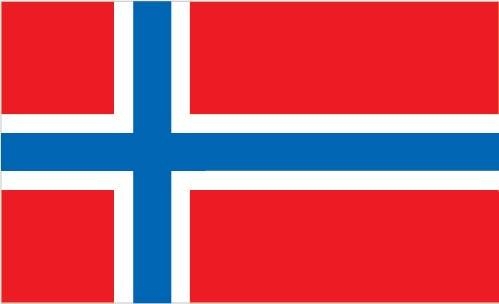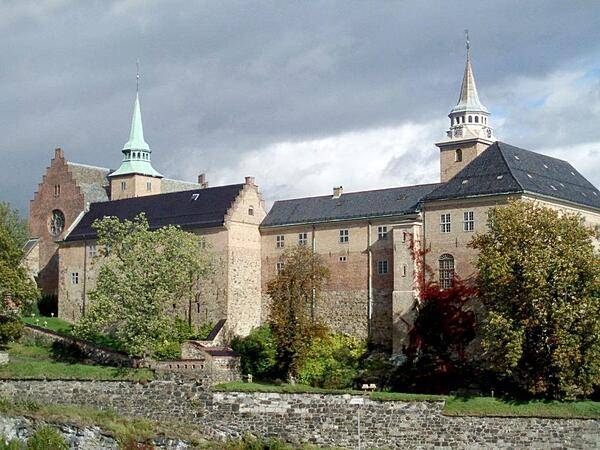101 Norway

Red with a blue cross outlined in white that extends to the edges of the flag. The vertical part of the cross is shifted to the hoist side in the style of the Dannebrog (Danish flag). The colors recall Norway’s past political unions with Denmark (red and white) and Sweden (blue).
Flag courtesy of the CIA World Factbook

Map courtesy of the CIA World Factbook

Akershus Fortress is a medieval castle built to protect the city of Oslo; construction dates back to the late 1290s. Today the grounds house several museums and are popular visitor destination.
Photo courtesy of the CIA World Factbook
Government
According to Britannica, Norway is a constitutional hereditary monarchy. The government, comprising the prime minister and the Statsråd (Council of State), is nominally chosen by the monarch with the approval of the Storting (Stortinget), the country’s legislature. Until 2009 the Storting operated as a bicameral body, though most matters were addressed in unicameral plenary sessions. Only when voting on laws was the Storting divided into two houses. One-fourth of the members were chosen to constitute the Lagting, or upper house, while the remaining members constituted the Odelsting, or lower house. Bills had to be passed by both houses in succession. In 2009 the Lagting was dissolved, and the Storting became permanently unicameral.
The constitution of Norway, drafted in 1814 when Norway left the 434-year union with Denmark, was influenced by British political traditions, the Constitution of the United States, and French Revolutionary ideas. Amendments can be made by a two-thirds majority in the Storting. Unlike many parliamentary forms of legislature, the Storting cannot be dissolved during its four-year term of office (amendments to overturn this restriction have been defeated frequently since 1990). If a majority of the Storting votes against an action advocated by the Statsråd, the minister responsible or the whole Statsråd resigns. In legislative matters the monarch has a suspending right of veto, but, since the 91-year union with Sweden was dissolved in 1905, this veto has never been exercised.
The Sami Act of 1987 sought to enable the Sami people “to safeguard and develop their language, culture, and way of life” and created the Sameting, the Sami Parliament, the business of which, according to the constitution, is “any matter that in the view of the parliament particularly affects the Sami people.”
The Finnmark Act, adopted by the Storting in 2005, transferred some 95 percent of the fylke (county) of Finnmark from state ownership to its residents through the establishment of the Finnmark Estate. The act recognized in particular that the Sami people, through protracted traditional use of the area, had acquired individual and collective ownership of the area and the right to use its land and water.
The city of Oslo constitutes one of the country’s 19 fylker (counties). The other counties are divided into rural and urban municipalities, with councils elected every fourth year (two years after the Storting elections). For the country as a whole, the municipal elections tend to mirror the party division of the Storting. The municipal councils elect a board of aldermen and a mayor. Many municipalities also employ councillors for such governmental affairs as finance, schools, social affairs, and housing. Norwegians pay direct taxes to both federal and municipal governments.
The counties can levy taxes on the municipalities for purposes such as roads, secondary schools, and other joint projects. The county councils comprise delegates from the municipalities, while the county governors are appointed by the Statsråd.
Before civil cases ordinarily can be taken to court, they first must be submitted to the local conciliation boards (forliksråd), which settle many issues without recourse to more formal legal action. Decisions of the conciliation boards can be appealed to the courts, and Norway also has a formal system of courts of appeal. The Supreme Court is the final arbiter of legal decisions. The rights of the citizens also are guarded by ombudsmen, who act on their behalf as an intermediary in matters with public administrators.
Civil Aviation Authority (CAA) of Norway
The Civil Aviation Authority (CAA) of Norway’s main objective is to contribute to safe civil aviation in Norway.
Airspace
SkyVector – Google Maps – ADS-B Exchange
ICAO countries publish an Aeronautical Information Publication (AIP). This document is divided into three parts: General (GEN), En Route (ENR) and Aerodromes (AD). ENR 1.4 details the types of airspace classes they chose to adopt from classes A through G.
Avinor
Drone Regulations
C-UAS
Countering the Drone Threat: Implications of C-Uas Technology for Norway in an EU and NATO Context
Advanced Air Mobility (AAM) Regulations & Policies
Bilateral agreements facilitate the reciprocal airworthiness certification of civil aeronautical products imported/exported between two signatory countries. A Bilateral Airworthiness Agreement (BAA) or Bilateral Aviation Safety Agreement (BASA) with Implementation Procedures for Airworthiness (IPA) provides for airworthiness technical cooperation between the FAA and its counterpart civil aviation authorities.
Bilateral Airworthiness Agreement
Bilateral Aviation Safety Agreement – Executive Agreement
Revised Export Documentation Requirement For Engines And Propellers
2016 Notification of Policy Deviation Memorandum for FAA Order 8130.21H
Advanced Air Mobility (AAM) News
2025
Video courtesy of Advanced Air Mobility Institute from the July 2025 Global AAM Forum.
2025 – Bristow and Beta Start Testing Electric Aircraft Routes in Norway
2025 – EASA Signs Contract with Elfly for Noemi Electric Seaplane Prototype
2025 – Bristow Poised to Start Electric Aircraft Operations in Norway
2025
Video courtesy of Advanced Air Mobility Institute from the January 2025 Global AAM Forum. Complete session for Day 2 of this Forum is available on the Advanced Air Mobility Institute YouTube Channel
2025 – BETA ROLLS OUT ALIA CX300 ELECTRIC AIRPLANE BOUND FOR NORWAY
2025 – Norway’s first procurement of electric aircraft chargers
2025 – Thales Selected to Deploy UTM System in Norway
2024 – Bristow, Beta, partners to open AAM cargo test flight area in Norway
Short Essay Questions
Scenario-Based Question
You have been hired by a Drone Startup Company. Your boss has immediately assigned this job to you.
They need you to prepare a one-page memo detailing the legalities of using a drone to film in Oslo, pictured above.
They need you to mention any national laws and local ordinances.
They specifically want to know what airspace (insert pictures) you will be operating in and whether or not you need an airspace authorization.
Does it matter whether or not you are a citizen of the country?
Lastly, there is a bonus for you if, as you scroll through this chapter, you find any typos or broken links!
Short Essay Questions
- What are the drone categories?
- How is registration addressed?
- How is remote ID addressed?
- What are the model aircraft rules?
- What are the commercial drone rules?
- Are there waivers or exemptions to the rules? If so, for what?
- Would you share a link to an interactive airspace map?
- How is BVLOS addressed?
- How can you fly drones at night?
- How can you fly drones over people?
- Where do you find drone NOTAMs?
- What are the rules for drone maintenance?
- What are the rules for an SMS program?
- What are some unique rules not mentioned above?
- What are the C-UAS rules?
- What are the AAM rules?

